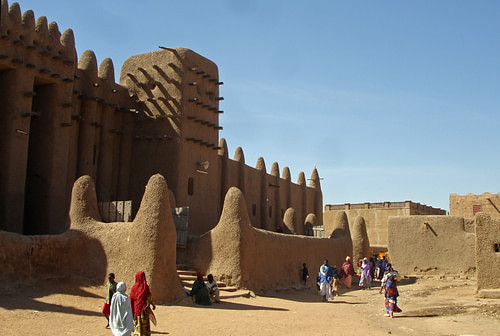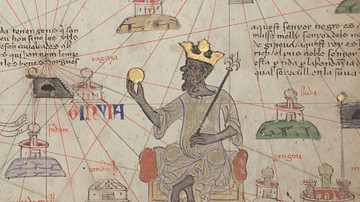
The Mali Empire (1240-1645) of West Africa was founded by Sundiata Keita (r. 1230-1255) following his victory over the kingdom of Sosso (c. 1180-1235). Sundiata's centralised government, diplomacy and well-trained army permitted a massive military expansion which would pave the way for a flourishing of the Mali Empire, making it the largest yet seen in Africa.
The reign of Mansa Musa I (1312-1337) saw the empire reach new heights in terms of territory controlled, cultural florescence, and the staggering wealth brought through Mali's control of regional trade routes. Acting as a middle-trader between North Africa via the Sahara desert and the Niger River to the south, Mali exploited the traffic in gold, salt, copper, ivory, and slaves that crisscrossed West Africa. Muslim merchants were attracted to all this commercial activity, and they converted Mali rulers who in turn spread Islam via such noted centres of learning as Timbuktu. In contrast to cities like Niani (the capital), Djenne, and Gao, most of the rural Mali population remained farmers who clung to their traditional animist beliefs. The Mali Empire collapsed in the 1460s following civil wars, the opening up of trade routes elsewhere, and the rise of the neighbouring Songhai Empire, but it did continue to control a small part of the western empire into the 17th century.
West Africa & the Sudan Region
The Sudan region of West Africa where the Mali Empire would develop had been inhabited since the Neolithic period as evidenced by Iron Age tumuli, megaliths, and remains of abandoned villages. The Niger River regularly flooded parts of this dry grassland and savannah, which provided fertile land for agriculture beginning at least 3,500 years ago, an endeavour greatly helped by the region's adequate annual rainfall. Cereals such as red-skinned African rice and millet were grown with success, as were pulses, tuber and root crops, oil and fibre plants, and fruits. Fishing and cattle herding were other important sources of food, while local deposits of copper were exploited and used for trade. Similarly, gold was probably locally mined or panned and then traded, but concrete evidence from this period is lacking.
The Ghana Empire (6th to 13th century) was the first major political power in West Africa to create an empire based on military might and the wealth gained from regional trade. Not geographically connected to modern-day Ghana but located to the northwest, the empire was in serious decline by the end of the 12th century. Beset by civil wars, rebellions of subjugated chiefdoms, and poor harvests, the empire began to disintegrate with a large part of its territory taken over by the kingdom of Sosso (aka Susu). When the Sosso king Sumanguru (aka Sumaoro Kante, r. from c. 1200), imposed trade restrictions on the Mali region, the native Malinke (Mandingo) tribe rose in rebellion.
Sundiata Keita & Government
Sundiata Keita (aka Sunjaata or Sundjata, r. 1230-1255) was a Malinke prince, whose name means 'lion prince', and he waged war against the kingdom of Sosso from the 1230s. Sundiata formed a powerful alliance of other disgruntled chiefs tired of Sumanguru's harsh rule and defeated the Sosso in a decisive battle at Krina (aka Kirina) in 1235. In 1240 Sundiata captured the old Ghana capital. Forming a centralised government of tribal leaders and a number of influential Arab merchants, this assembly (gbara) declared Sundiata the supreme monarch and gave him such honorary titles as Mari Diata (Lord Lion). The name Sundiata gave to his empire, Africa's largest up to that point, was Mali, meaning 'the place where the king lives'. It was also decreed that all future kings would be selected from the Keita clan, although the title was not necessarily given to the eldest son of a ruler, which sometimes led to fierce disputes among candidates.
The Mansa, or king, would be assisted by an assembly of elders and local chiefs throughout the Mali Empire's history, with audiences held in the royal palace or under a large tree. The king was also the supreme source of justice, but he did make use of legal advisors. In addition, the king was helped by a number of key ministers such as the chief of the army and master of the granaries (later treasury), as well as other officials like the master of ceremonies and leader of the royal orchestra. Nevertheless, the Mansa acted as a supreme monarch and monopolised key trade goods, for example, only he was permitted to possess gold nuggets, traders had to make do with gold dust. The king had certain mystical qualities attributed to him, and all slaves were exclusively loyal to him. No person had the right to be in the king's presence when he ate, for example, and all visitors before him had to be barefoot and bow down and pour dust over their heads. Such was this cult of leadership and the extreme centralisation of government in a single figure that the fortunes of the empire rose and fell depending on the talents or lack of them possessed by a particular king.
These problems of governance were yet to come, though, and Sundiata would continue to expand his territory to include the old kingdoms of Ghana, Walata, Tadmekka, and Songhai. Niani, now no longer in existence but probably located on a plain near the all-year-round navigable Sankarani River, was selected as the empire's capital. It was protected by mountains and was close to the two key sources of trade goods: forests and waterways.
Tribute was acquired from conquered chiefdoms, although many local chiefs were permitted to continue to rule their own people but with a Mali-appointed governor to assist them, often backed by a garrison. Additional guarantees of loyalty included taking royal hostages and keeping them at the capital. This federation prospered, developing over the next century into one of Africa's richest ever empires whose wealth would astound both Europe and Arabia. Further, and perhaps more important for the ordinary people of Mali, foreign visitors noted the high degree of justice they saw, the safety with which one could travel from place to place, and the abundance of food in all villages.
Trade & Timbuktu
Like its political predecessors, the Mali Empire prospered thanks to trade and its prime location, situated between the rain forests of southern West Africa and the powerful Muslim caliphates of North Africa. The Niger River provided ready access to Africa's interior and Atlantic coast, while the Berber-controlled camel caravans that crossed the Sahara desert ensured valuable commodities came from the north. The Mali rulers had a triple income: they taxed the passage of trade goods, bought goods and sold them on at much higher prices, and had access to their own valuable natural resources. Significantly, the Mali Empire controlled the rich gold-bearing regions of Galam, Bambuk, and Bure. One of the main trade exchanges was gold dust for salt from the Sahara. Gold was in particular demand from European powers like Castille in Spain and Venice and Genoa in Italy, where coinage was now being minted in the precious metal.
Timbuktu, founded c. 1100 by the nomadic Tuaregs, was a semi-independent trade port which had the double advantage of being on the Niger River bend and the starting point for the trans-Saharan caravans. The city would be monopolised and then taken over by the Mali kings who made it into one of the most important and most cosmopolitan trade centres in Africa. Through Timbuktu there passed such lucrative goods as ivory, textiles, horses (important for military use), glassware, weapons, sugar, kola nuts (a mild stimulant), cereals (e.g. sorghum and millet), spices, stone beads, craft products, and slaves. Goods were bartered for or paid using an agreed upon commodity such as copper or gold ingots, set quantities of salt or ivory, or even cowry shells (which came from Persia).
Mansa Musa I
After a string of seemingly lacklustre rulers, the Mali Empire enjoyed its second golden era during the reign of Mansa Musa I in the first half of the 13th century. With an army numbering around 100,000 men, including an armoured cavalry corps of 10,000 horses, and with the talented general Saran Mandian, Mansa Musa was able to maintain and extend Mali's empire, doubling its territory. He controlled lands up to the Gambia and lower Senegal in the west; in the north, tribes were subdued along the whole length of the Western Sahara border region; in the east, control spread up to Gao on the Niger River and, to the south, the Bure region and the forests of what became known as the Gold Coast came under Mali oversight. The Mali Empire thus came to include many different religious, ethnic, and linguistic groups.
To govern these diverse peoples, Mansa Musa divided his empire into provinces with each one ruled by a governor (farba) appointed personally by him and responsible for local taxes, justice, and settling tribal disputes. The administration was further improved with greater records kept and sent to the centralised government offices at Niani. With more tribute from more conquered chiefs, more trade routes under Mali control, and even more natural resources to exploit, Mansa Musa and the Mali elite became immensely rich. When the Mali king visited Cairo in 1324, he spent or simply gave away so much gold that the price of bullion crashed by 20%. Such riches set off a never-ending round of rumours that Mali was a kingdom paved with gold. In Spain c. 1375, a mapmaker was inspired to create Europe's first detailed map of West Africa, part of the Catalan Atlas. The map has Mansa Musa wearing an impressive gold crown and triumphantly brandishing a huge lump of gold in his hand. European explorers would spend the next five centuries trying to locate the source of this gold and the fabled trading city of Timbuktu.
Spread of Islam
Islam spread through parts of West Africa via the Arab merchants who traded there. Noted Muslim travellers and chroniclers like Ibn Battuta (1304 - c. 1369) and Ibn Khaldin (1332-1406) recorded that even Mali's first ruler Sundiata converted to Islam. However, the Malinke oral tradition, which was kept up over the generations by specialised bards (griots), presents a different story. Although recognising Islam was present in Mali long before Sundiata's reign, the oral tradition maintains that the first ruler of the Mali Empire did not reject the indigenous animist religion. We do know that Sundiata's son, Mansa Uli (aka Mansa Wali or Yerelenku), went on a pilgrimage to Mecca in the 1260s or 1270s, and this would be a continuing trend amongst many of Mali's rulers.
Islam in West Africa really took off, though, from the reign of Mansa Musa I. He famously went to Mecca and, impressed with what he saw on his travels, Mansa Musa brought back home Muslim architects, scholars, and books. Mosques were built such as Timbuktu's 'Great mosque' (aka Djinguereber or Jingereber), and Koranic schools and universities were established which quickly gained an international reputation. Studies were actually much wider than religion and included history, geography, astronomy, and medicine. Great libraries were built up with tens of thousands of books and manuscripts, many of which survive today.
As more people were converted, so more Muslim clerics were attracted from abroad and the religion was spread further across West Africa. Many native converts studied in such places as Fez, Morocco, and became great scholars, missionaries, and even saints, and so Islam came to be seen no longer as a foreign religion but a black African one. Despite the spread of Islam, it is also true that ancient indigenous animist beliefs continued to be practised, especially in rural communities, as noted by travellers like Ibn Battuta who visited Mali c. 1352. In addition, Islamic studies were conducted in Arabic not native languages, and this further impeded its popularity outside the educated clerical class of towns and cities. Even the Islam that did take hold in Mali was a particular variation of that practised in the Arab world, perhaps because Mali rulers could not afford to completely dismiss the indigenous religious practices and beliefs that the majority of their people clung on to.
Mali Architecture
The buildings of the Mali Empire, some of which like the Sankore mosque in Timbuktu still stand, are one of the most recognisable features of the region and have become international symbols of Africa's rich pre-colonial history. Mali architects had a distinct disadvantage because of the rarity of stone in the region, and for this reason, buildings were typically constructed using beaten earth (banco) reinforced with wood which often sticks out in beams from the exterior surfaces. Despite the limited materials, the mosques, in particular, are still imposing multi-storied structures with towers, huge wooden doors, and tiered minarets. Other large buildings included warehouses (fondacs) which were used to store goods before they were transported elsewhere and which had up to 40 apartments for merchants to live in. Other examples of the Mali baked-mud buildings which impress today, although many are early 20th-century reconstructions, include the huge mosques at Mopti and Djenne.
On a smaller scale, excavations at Niani have revealed the remains of houses and their stone foundations, confirming later sources that the richer members of society built stone houses. Arab chroniclers describe another type of domestic building, which was constructed using beaten earth bricks and with ceilings made of wooden beams and reeds, the whole formed into a conical roof. Flooring was made using earth mixed with sand.
Mali Art & Culture
We have already noted that the Malinke had a rich tradition of recounting legends and community histories orally by specialised story-tellers know as griots. These stories, passed down from generation to generation (and continuing today), were often accompanied by music. During the Mali Empire, there were even songs reserved for certain people who alone had the right to have them sung in their honour, this was especially so for renowned warriors and hunters. Music was also an important part of religious festivals when masked dancers performed.

Pottery and sculpture were produced, as they had been at noted centres like Djenne since the 9th century. Sculptures are generally up to 50 cm tall and made of solid pottery but sometimes with a reinforcing iron rod interior. Wood and brass were other popular materials for sculpture and, to a lesser degree, stone. Decoration is typically incised, painted, or achieved by adding three-dimensional pieces. Subjects include human figures, especially bearded warriors riding a horse but also many kneeling or crouching figures with upturned faces. Figures are often realistic portrayals of ordinary people, sometimes showing symptoms of tropical diseases. Although it is rare for artworks of this period to come with a certain provenance obtained from professionally excavated sites, the sculptures are so numerous that it seems likely many were used as everyday decorative objects as well as for ritual or burial purposes.
Decline
The Mali Empire was in decline by the 15th century. The ill-defined rules for royal succession often led to civil wars as brothers and uncles fought each other for the throne. Then, as trade routes opened up elsewhere, several rival kingdoms developed to the west, notably the Songhai. European ships, especially those belonging to the Portuguese, were now regularly sailing down the west coast of Africa and so the Saharan caravans faced stiff competition as the most efficient means to transport goods from West Africa to the Mediterranean. There were attacks on Mali by the Tuareg in 1433 and by the Mossi people, who at that time controlled the lands south of the Niger River. Around 1468, King Sunni Ali of the Songhai Empire (r. 1464-1492) conquered the rump of the Mali Empire which was now reduced to controlling a small western pocket of its once great territory. What remained of the Mali Empire would be absorbed into the Moroccan Empire in the mid-17th century.














